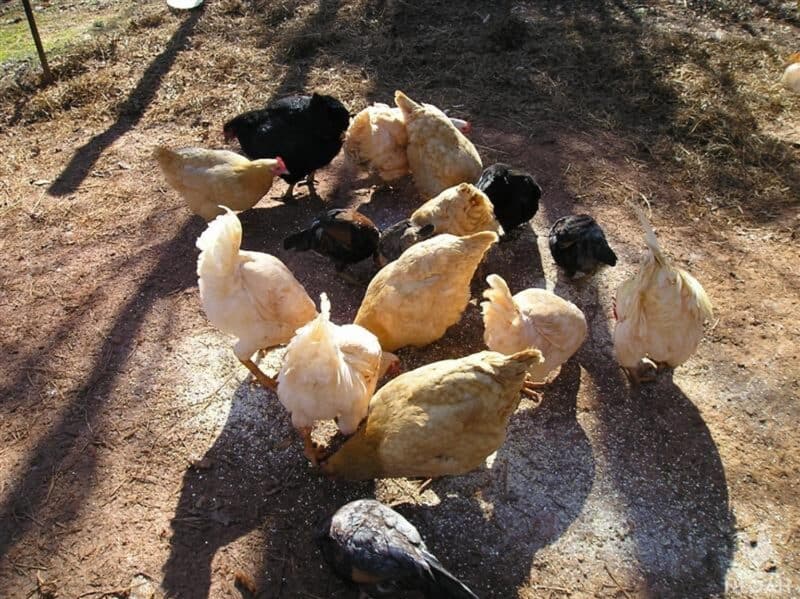Lambsquarters is a common weed that is often found growing in gardens and fields. The plant is easy to identify by its distinctively shaped leaves, which are divided into three parts and have a blue-green color.

Lambsquarters are actually a type of goosefoot, and they are related to quinoa and spinach. But, like so many things, what is okay for people is not necessarily okay for chickens.
Can chickens eat lambsquarters?
Chickens probably shouldn’t eat lambsquarters. The matter is contentious, but the plant contains high levels of oxalates, which can be harmful to chickens (and people) if consumed in large quantities. These oxalates can interfere with the blood’s ability to carry oxygen. This can lead to respiratory problems and even death.
Though a little bit of lambsquarters probably won’t hurt, extreme caution is advised since the amount of oxalates in any given plant, and part of the plant, varies greatly.
Keep reading and we will tell you everything you need to know about lambsquarters and chickens.
Chickens Should Only Eat Lambsquarters Sparingly, if at All
As was said, lambsquarters contains high levels of oxalates. These are compounds that occur naturally in plants, and they serve as a defense against predators.
When animals (or people) consume large quantities of oxalates, the compounds can form crystals in the body and cause health problems.
The crystals can damage organs, and if they form in the blood vessels, they can interfere with the blood’s ability to carry oxygen. This can lead to respiratory problems and even death.
Though some chicken owners claim to have fed or allowed their birds to feed on lambsquarters without any ill effects, the mechanisms by which oxalates cause harm is well understood.
If you are wise, you won’t let your flock eat lambsquarters; there are plenty of other healthy, nutritious wild plants they can forage on.
Some Species of Lambsquarters Produce More Toxic Compounds than Others
Perhaps the contention regarding the safety and viability of lambsquarters as a food for chickens is predicated on the sheer variability of the toxic oxalates in the plant itself; some species of lambsquarters are demonstrably more toxic than others.
A study published in the journal “Weed Science” in 1984 looked at the oxalate levels in several common species of lambsquarters (Chenopodium album), including the “jointed goatgrass”, “melde”, and “lamb’s-quarters”.
The study found that the jointed goatgrass had the highest levels of oxalates, followed by the melde and then the lamb’s-quarters.
The study also found that the level of oxalates in a given plant varied depending on the time of year and the part of the plant being tested.
For example, the leaves contained more oxalates than the stems, and the oxalate levels were higher in plants that were harvested in the summer than in those that were harvested in the spring.
For clarity, the amount of oxalates in any given plant, and part of the plant, varies greatly! The level of toxicity also depends on the age and overall health of the chicken, too.
This variability means that it is difficult to say definitively whether or not lambsquarters are outright harmful to chickens or only a certain quantity.
However, given the potential risks, it is probably best to play it safe rather than be sorry!
Effects of Oxalate Poisoning in Chickens
The effects of oxalate poisoning in chickens can be severe and even fatal.
Some of the symptoms of oxalate poisoning include respiratory distress, cyanosis (a bluish tint to the skin, comb or wattles caused by lack of oxygen in the blood), weakness, paralysis, tremors, seizures and coma.
Death is unlikely except in serious poisonings but cannot be rules out as a complication.
If you think your chicken has been poisoned by lambsquarters (or any other plant), it is important to seek veterinary care immediately.
The sooner the chicken receives treatment, the better their chances are of making a full recovery.
Can Chickens Eat Lambsquarters Raw?
Assuming you decide to let your chickens eat lambsquarters, yes, they may eat the plant raw.
Can Chickens Eat Lambsquarters Cooked?
Yes, lambsquarters may be cooked and served to chickens although it should be pointed out this does not significantly diminish the oxalates present in the plant, much of the time.
Lambsquarters is not any safer for chickens just because it has been cooked.
Beware of Pesticide and Herbicide on Wild Lambsquarters
Another worry with serving your flock lambsquarters is the possible presence of herbicides and pesticides.
These toxic chemicals can accumulate in plants, and when chickens consume the plants, the toxins can build up in their bodies, too.
The only way to be sure that the lambsquarters your chickens are eating haven’t been sprayed with herbicides or pesticides is to grow them yourself on your property.
If you forage for them in the wild, you have no way of knowing what kind of chemicals might be present.
Also keep in mind that the plant can absorb chemicals in the form of runoff from farms or industrial sites, so take extra caution if you collect any growing near these places.
How Often Can Chickens Have Lambsquarters?
If you decide to serve lambsquarters to your flock, they should have it only very sparingly. Chickens should live mostly on their chicken feed, with 90% of their calories coming from it.
The remaining 10% can be made up of various, wholesome foods and snacks, of which lambsquarters should be only a small fraction considering the risks.
Can Baby Chicks Have Lambsquarters, Too?
You are highly advised to avoid feeding lambsquarters to chicks in any capacity or at any age.
Chicks are even more susceptible to the effects of oxalates than adult chickens, so it is best to steer clear altogether.
Tom has lived and worked on farms and homesteads from the Carolinas to Kentucky and beyond. He is passionate about helping people prepare for tough times by embracing lifestyles of self-sufficiency.
